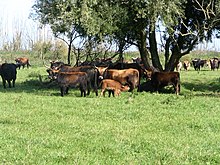Oostvaardersplassen
[7] Before the establishment of the reserve, the dry area was a nursery for willow trees, and in the first year hundreds of seedlings could be found on each square metre.To avoid this, the park's managers brought in a number of large herbivores to keep the area more open, including Konik horses, red deer and Heck cattle.The tarpan and aurochs are extinct, but Konik ponies and Heck cattle are able to act as functional equivalents, occupying a similar ecological niche.[18] In the winter of 2017–2018, almost 3.300 deer, horses and cattle starved to death[19] dividing[20] the Dutch public[21] and leading to demonstrations and individuals feeding hay to the animals despite police arrests.The "Ecological Main Structure" plan proposes connections between nature reserves in the Netherlands, calling for a corridor to be created toward nearby Horsterwold [nl].In 2012 the creation of Oostvaarderswold [nl], the 7 × 1 mi connecting corridor between Oostvaardersplassen and the Horsterwold, was stopped, and four members of the regional parliament resigned.
FlevolandNetherlandsLelystadRamsar Wetlandnature reserveStaatsbosbeheerrewildingpolderRamsarNieuw Land National ParkAlmeresquare kilometresMarkermeerFlevopolderreedbedsgreylag geeseSpecial Protection Areagreat cormorantcommon spoonbillgreat egretwhite-tailed eagleEurasian bitterncommon kingfishergrey heroncommon ravenbarnacle gooselittle egretSavi's warblerbearded reedlingred foxNicrophorus vespillowillowred deerHeck cattlecastratingEurasian wolfEurasian brown bearEurasian lynxtarpanwisentaurochselk (Alces alces)roe deerwild boarVeluwegrazerscorridorsNatura 2000GelderlandDe Nieuwe WildernisPleistocene ParkWood-pasture hypothesisGeorge MonbiotThe New YorkerWayback MachineConvention on Biological Diversity
